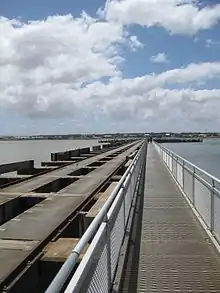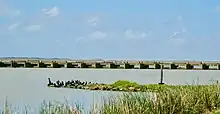
The Goolwa Barrages comprise five barrage structures in the channels separating Lake Alexandrina from the sea at the mouth of the River Murray and the Coorong in South Australia. They were constructed principally to reduce salinity levels in the lower reaches of the River Murray, Lake Alexandrina and Lake Albert, but also to stabilise the river level, for both upstream irrigation and pumping.

History
Prior to the construction of the barrages, during periods of low river flow, tidal effects and the intrusion of seawater were felt up to 250 kilometres (160 miles) upstream from the mouth of the River Murray, approximately as far inland as the river port at present-day Swan Reach.[1][2]
From the 1900s, with the advent of large irrigation schemes, landowners along the lower reaches of the river strongly urged for the construction of barrages, primarily to keep the water fresh in the lower reaches of the River Murray, as well as Lake Albert and Lake Alexandrina.
In 1931, the Murray-Darling Basin Commission authorised the construction of five barrages. Work commenced in 1935 and was completed in 1940. South Australia's Engineering and Water Supply Department undertook the project, with costs shared equally by the governments of South Australia, Victoria, New South Wales and the Commonwealth of Australia.
Description

The system consists of five barrages extending from Sir Richard Peninsula in the west to Pelican Point on the northern side of the mouth of the Coorong in the east, crossing five channels between the mainland and three islands. From west to east, the five barrages are named Goolwa, Mundoo, Boundary Creek, Ewe Island and Tauwitchere.[2]
Goolwa Barrage
The Goolwa Barrage connects Sir Richard Peninsula on the mainland 35°31′43″S 138°48′29″E / 35.528552°S 138.808077°E with Hindmarsh Island 35°31′24″S 138°48′33″E / 35.523210°S 138.809190°E. This barrage includes a lock, which measures 30.5 m by 6.1 m.[2]
Mundoo Barrage
The Mundoo Barrage connects Hindmarsh Island with Mundoo Island.[2]
Boundary Creek Barrage
The Boundary Creek Barrage connects Mundoo Island with Ewe Island.[2]
Ewe Island Barrage
The Ewe Island Barrage connects Ewe Island with Tauwitchere Island.[2]
Tauwitchere Barrage
The Tauwitchere Barrage connects Tauwitchere Island with Pelican Point on the mainland. The lock in this barrage, provided for fishing boats, measures 13.7 m by 3.8 m.[2]
Engineering heritage award
The barrages are listed as a National Engineering Landmark by Engineers Australia as part of its Engineering Heritage Recognition Program.[3]
See also
References
- ↑ Murray Darling Basin Commission, ""Barrages - Murray Darling Basin Commission - http://www.mdbc.gov.au". Archived from the original on 19 March 2012. Retrieved 17 November 2012.
{{cite web}}: External link in|title= - 1 2 3 4 5 6 7 "Lower Lakes Barrages". Murray-Darling Basin Authority. Archived from the original on 9 January 2015. Retrieved 9 January 2015.
- ↑ "River Murray Barrages, 1935 to 1940-". Engineers Australia. Retrieved 7 May 2020.